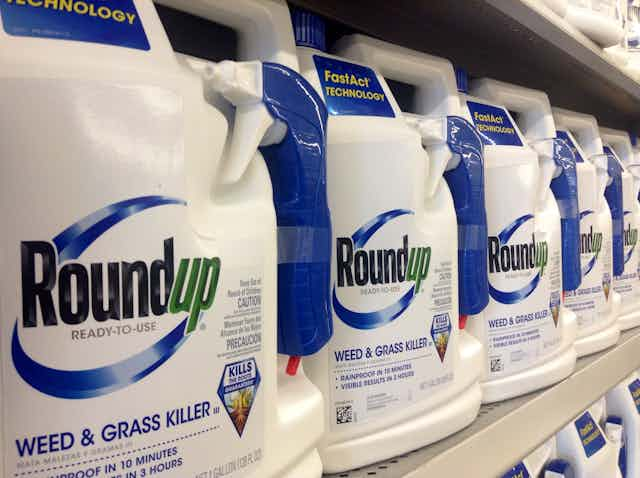A group of rural Victorians has petitioned their local council to stop using the household weed-killer Roundup (glyphosate).
Their concerns centre around an assessment made last year by the International Agency for Research on Cancer (IARC) – an arm of the World Health Organisation – that the common herbicide was “probably carcinogenic to humans”.
The IARC had found limited evidence of carcinogenicity in humans for non-Hodgkin’s lymphoma, mostly in agricultural workers.
Victoria’s Mount Alexander Shire Council has resolved to continue using the herbicide. Councillors have, however, adopted a resolution to “seek alternative methods” to reduce “the use of glyphosate and other weed control chemicals”.
In Queensland, councils are also investigating whether they should continue using glyphosate for the same reason.
But the concern of the councils and residents isn’t warranted. Glyphosate isn’t actually dangerous at the levels at which children, or the incidental park passerby, are exposed.
‘Probably’ carcinogenic
Glyphosate is an organic compound that kills weeds by interfering with the plants’ metabolism. In Australia, it’s been registered for use for more than 40 years.
But it’s also classified as “probably carcinogenic to humans”, which means children should stay away from it. Right? Well, no.
The IARC classifies agents that “probably” cause human cancers into Group 2A. This is below Group 1 that hosts agents definitely proven to be carcinogenic to humans. They include tobacco smoke and asbestos.
For Group 1 substances, relevant studies are consistent and indicate cancer causation definitively. But then there’s Group 2A with the term “probably”. Here some scientific data fall short of proof. For glyphosate and many other chemicals, the relevant studies are not consistent.
The people most heavily exposed to glyphosate are those employed to spray or apply it. These were the people subject to investigations on which IARC based its determination.
Some studies have shown workers using glyphosate have more of a certain type of lymphoma (a cancer of blood-forming cells) than the average population. Other studies, including the biggest such investigation, have not.
Discrepancies are common in epidemiology, which is a study of diseases in populations. Epidemiologists use qualifiers such as “probably” or “possibly” rather than indicating that one or more studies are wrong.
But people often misunderstand what action must be taken when something has been determined as “probably carcinogenic”.
Risk assessment
The IARC evaluations identify hazards – that is, whether a certain substance has the biological capability to cause cancer. A hazard identification is only one part of the process to determine whether a chemical is dangerous for use.
If it is capable of causing cancer, or probably is, then a separate level of investigation is needed to determine under what circumstances people are exposed to the chemical, and then, what the likelihood is of it causing the cancer.
This exercise is called a “risk assessment” and is not addressed by IARC.
Risk assessment is the business of statutory authorities. For pesticide use in Australia, the relevant authority is the Australian Pesticides and Veterinary Medicines Authority (APVMA).
The APVMA regulates how glyphosate is to be used safely. Authorities like this take into account factors such as the circumstances of a chemical’s use, the level of exposure and availability of alternatives and protective measures – such as warning labels and protective equipment and clothing.
As already mentioned, glyphosate has only been found to be “probably” carcinogenic, and the studies on which this determination was based were confined to those most exposed to the chemical (those who use it occupationally).
But what about the rest of us, as in, the vast majority of Australians whose job doesn’t involve using glyphosate?
Glyphosate and the average child
Negative health effects of chemicals are mainly determined by the level of exposure to them. The good news is that soil microbes degrade glyphosate in a matter of days. It doesn’t accumulate the way some pesticides do.
The carcinogenicity evidence for glyphosate doesn’t involve incidental exposure for children. Such level of exposure, if measurable at all, would be hundreds of times below that of occupational exposure.
And when it comes to children, it’s not only the level of exposure that must be considered. It’s also the frequency of exposure when compared to those using it occupationally (possibly most days over a period of years, if not decades). So clearly, much less.
Children get to parks by crossing roads. That’s a risk and there are warning signs for it. When they get to a park, they also risk attack by dogs or humans, being struck by lightning or bitten by snakes. Although those risks are real, they don’t (in most cases) merit warning signs.
And then there’s the even lesser risk of cancer from residual glyphosate, which has never been documented. Just forget it.

